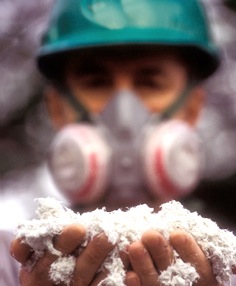
If the NY Insulation workers in hazmat garb on the Domino complex in the infamous early April video were indeed performing asbestos removal, they certainly weren’t following industry or NYS/NYC protocol to protect public health. This hazmat removal method could represent gross negligence because voluminous quantities of dust were stirred up in an open air area caused by the ripping and sledge hammering of possible carcinogenic laden material, essentially a dirty bomb rooftop party. If the removal of alleged hazmat occurred in broad daylight on a rooftop, just imagine what is being done indoors out of public view and in the executive suite.
Asbestos, a Greek word meaning “inextinguishable,” has been used as building material since the Holy Roman Empire because of its heat and fire resistant properties. Its peak use in the US was between 1930 and 1970. According to the US Geological Survey the US continues to legally import asbestos annually primarily from Brazil, the third largest asbestos producer in the world. From January to July 2012, over 1,000 metric tons were imported. Interestingly, the US stopped producing asbestos domestically since 2002.
Asbestos particulates lodged in the lungs can result in Mesothelioma. It’s an aggressive cancer whose only cause is from asbestos. There are no safe levels of exposure and it often takes decades for symptoms to develop. This danger includes “take-home” exposure caused when someone tracks residual asbestos on their footwear or clothing into the home, thus exposing one’s family.
In the pursuit of obscene profits, real estate developers have no qualms about utilizing the most cost-effective methods to renovate industrial buildings. It’s profit maximization through excessive cost-cutting, by hiring non-union workers and performing removal methods that flaunt safety codes at the expense of public health.
Such an example is subcontracting a firm such as NY Insulation that was debarred and cannot perform work with any other NYS government agency. Regardless of this fact, they were hired by Two Trees, a high-profile, deep-pocket private firm.
One cannot shame or embarrass powerful real-estate developers. Even negative publicity is a minor irritant because they shroud themselves in Teflon tailored by public relations firms. The only way to get their attention is to disrupt their construction critical path. The critical path is a series of deadlines to complete specific phases before the next one can be undertaken. The shorter the critical path, the greater the cash flow. Hazmat removal is one of the early phases on this critical path. For mega-projects like Domino any critical path delay is measured in hundreds of millions of dollars which reduces their profit margin.
After Domino is gutted and renovated, it will be described as a fully-restored, classic masterpiece with Great Gatsby amenities with a sky is the limit price tag. Domino is the ultimate Williamsburg trophy project, and Two Trees will certainly profit big-time, whatever the final outcome with respect to development. The key is whether they can step up ethically and become socially responsible to the community by contracting qualified and credible firms to perform the necessary work.
With the mayoral campaign in full swing, this is the opportunity to grill the candidates on their proposed policies on protecting public health by ensuring that hazmat removal meets government requirements. Equally important is whether the candidates have any conflicts of interest such as their sources of campaign financing that may compromise their ability to stand up to real estate developers who engage in questionable practices.
—Albert Goldson is an Architectural & Engineering Contract Manager specializing in transportation megaprojects, energy, and urban planning. He is a long-term Williamsburg resident, an internationalist, and avid jazz aficionado.
Leave a Reply